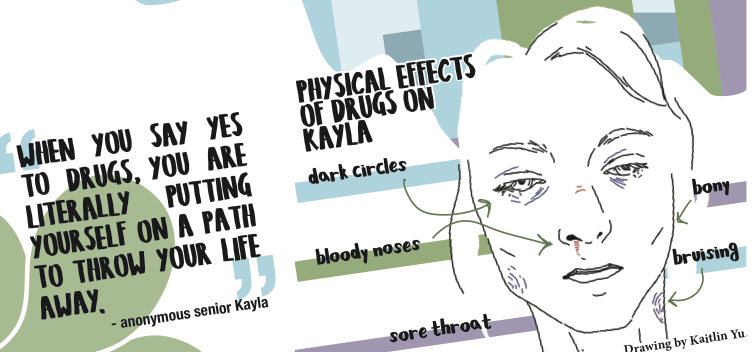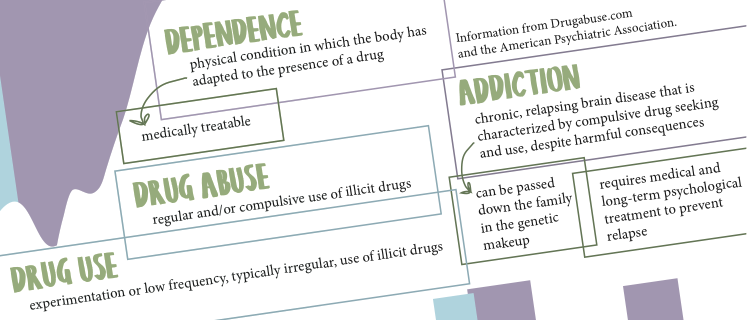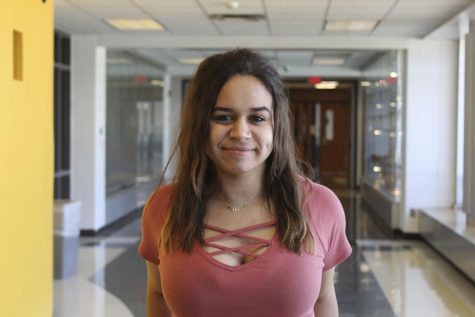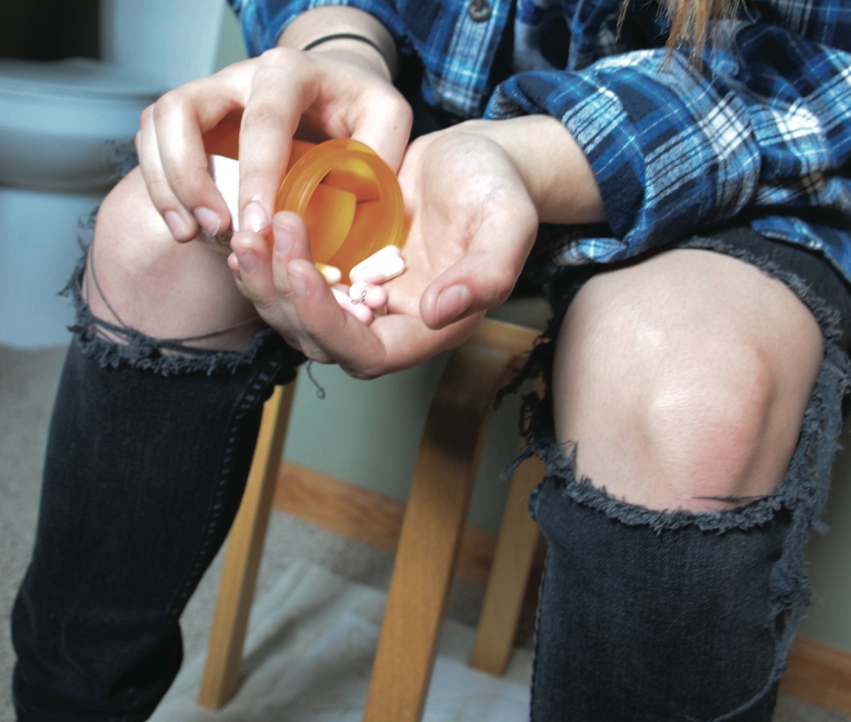Under the Influence
Drug abuse prompts investigation of its ramifications
With Our Lives
With a growing drug epidemic wreaking havoc across the United States, The Tiger Print acknowledges the necessity to analyze Blue Valley’s own struggle with illegal substances. Drawing upon the accounts of students, officers, professionals and administration, the staff looked to answer the issue of how drugs and their legal consequences affect people’s daily lives.
Kayla* shared with The Tiger Print how she overcame drug use and how her struggle drastically affected her relationships.
She said she started smoking marijuana in the eighth grade and then transitioned to more dangerous drugs when she began going to raves.
“I started doing party drugs like acid and shrooms,” she said. “Eventually, I got into doing pills like OxyContin and Xanax. When I had just started [with heroin,] my parents found out about everything. I was able to be hospitalized, and I am very thankful for that.”
 Kaitlin Yu
Kaitlin Yu
Kayla said she began using drugs as a way to escape her depression and suicidal thoughts.
“Using drugs was a coping mechanism,” she said. “With opioids and heroin, you really forget where you are and what’s happening with your life.”
However, Kayla said being able to escape her problems was temporary — she continually reached for more to satisfy her addiction. She said she would often wake up not knowing where she was or the people she was with.
“When you’re not high anymore, everything in your life comes rushing back,” she said. “It never helps unless you keep using the drug to stay high [all the time. After I got off the drug], I would feel really ashamed. A lot of times, I didn’t remember what I did — I just remembered it was all negative feelings — shame, unhappiness and disappointment with myself.”
In addition to having dark circles and sunken eyes due to lack of sleep, Kayla said the physical toll drugs took on her body was hard to ignore.
“I lost a ton of weight,” she said. “I was super bony at the time, and I definitely saw bruising — I bruised a lot easier if I was shooting up. My throat was in really bad condition and so were my sinuses because of snorting all the time — it would make my nose bleed.”
Kayla said she felt the relationships with the people closest to her fall apart due to her drug use. Even her parents began to question their relationship once they found out about her addiction.
“They didn’t understand — they thought they had done something wrong,” she said. “I was lying to them all the time, which made me feel bad because they are great parents. They didn’t deserve me treating them like that.”
Kayla said her parents were supportive and loving during her recovery process. However, when she began sobriety, she said it was hard because she lost her friends.
“They weren’t interested in being sober,” she said. “They thought I was acting like I was better than them. I knew I couldn’t put myself in those environments anymore because of the temptation, so I struggled with it by myself.”
When Kayla’s parents discovered she was using drugs, she said she was admitted to Marillac’s adolescent psychological unit for an intense four or five days.
“It was horrible,” she said. “[No patients] were allowed to have ties on clothing because the workers were afraid you would hang yourself. [The staff] would follow you into the bathroom — you weren’t allowed to be there alone. As soon as I got out, I knew I never would do that again.”
After Marillac, she said she was sent to an intensive outpatient rehabilitation center called Signature Behavioral Healthcare. She went every day after school for three hours from April through June.
“We met with different psychologists,” she said. “In terms of rehab, the mandatory drug testing was [beneficial] because they would immediately report it to your parents, and your graduation date for the program would be pushed back every time you failed a drug test.”
She said if a friend is addicted to any substance, it is a responsibility to tell an adult even if it is scary or ruins a relationship.
“You’re afraid they will never want to be your friend anymore, but the problem is, that person is way beyond your or their control, and they need professional help,” she said. “Helping someone else seek out professional help is honestly the best thing you can do for them. I can guarantee that, even if they don’t ever tell you, they are so grateful for having someone who actually cared enough to help them.”
Kayla said she is not ashamed of her story, but she’s embarrassed when people judge her.
“It has prevented relationships from moving forward because people don’t trust that I’m sober and fine now. They don’t want to be involved with someone who had drugs in their life.”
She said it is vital to share experiences with drug abuse so others can learn from past mistakes.
“No matter how fun something is or no matter how invincible you feel because you’ve never been caught, you will be caught,” she said. “Even if you’re not caught, someone will die or [overdose] or be hospitalized. When you say yes to drugs, you are literally putting yourself on a path to throw your life away. Don’t make that mistake [because] you have so many people that love and care about you.”
With Our Health
According to the National Institute on Drug Abuse, certain substances have been shown to alter gene expression and brain circuitry. While the initial use of the drug may have been voluntary, the brain will become addicted and lead a person to make impulsive decisions in order to obtain the substance again. When a person is unable to receive the drug, withdrawal symptoms will appear. These include sweating, hallucinations, self-harm, seizures and vomiting. The extent to which the withdrawal symptoms harm a person depends on the substance.
Brookdale Home Health clinical service manager Monica Decker, Registered Nurse (RN), said the abuse of these substances can have a range of impacts on the human body.
“Short-term effects from drug use can include abdominal pain, vomiting, changes in appetite, body temperature and sleeping patterns,” she said. “Long-term effects include contraction of HIV or hepatitis, heart attack, lung cancer, stroke and brain damage.”
The side effects that will appear depend on the drug in question and the person using them.
Staff nurse at Marillac, Maria Anderson, RN, said there are several impacts drugs can produce that many people are not aware of.
 Kaitlin Yu
Kaitlin Yu
“[Some forgotten side effects are] catatonia [— a disorder which results in loss of speach or mobility,] personality changes, PTSD, anxiety and depression,” she said. “Some people that have bad reactions to these drugs never speak again.”
According to a study published by Lancet Medical Journal, drugs like heroin, crack cocaine and methamphetamine are among the most dangerous drugs. Decker said street drugs typically have the greatest impact on the body.
“These are the most dangerous because of the unknown chemicals that can be used to produce these drugs and the unknown effects that these chemicals can have on the body,” she said.
While these drugs are well known, drugs like fentanyl, krokodil, ketamine and K2 have gained traction in the drug trade because of their highly addictive nature.
K2, a synthetic marijuana — often labeled as a legal alternative to marijuana — can have dangerous side effects including paranoia, panic attacks and catatonia.
Fentanyl, a synthetic opioid 50 times more potent than heroin, has been attributed to thousands of deaths yearly since it appeared in 2013.
Fentanyl isn’t the only opioid capable of this damage, though. According to the Center for Disease Control, the death rate of synthetic opioids outside of methadone, which includes fentanyl, increased by 72.2 percent from 2014 to 2015.
Anderson said teenagers should avoid using drugs altogether.
“Just don’t do it,” she said. “Any reason you could have for using drugs is not worth the potential consequences. You could use a drug 100 times, and the 101st time could be the time it kills you. There are resources available if you need help with addiction or any issue that you feel is leading you to use drugs.”
With Our Law
Kansas has mandates in place regarding controlled dangerous substances (CDS). Drugs like heroin are typically classified as a CDS, but the compounds used to create the final product may fall under the category as well.
Legislation classifies drugs using a system of levels called “Schedules.” The most dangerous drugs are listed in Schedule I; Schedule II and the remaining three all decrease in terms of danger and amount of abuse and increase in terms of recognized medical usage.
The penalties for illicit drug use can range from misdemeanors to fines to jail time.
At BV, the consequences for drug abuse results in suspension of up to 10 days. Beyond that, the district’s Suspension and Expulsion Committee may take further action if requested by the school. The suspension can be reduced if the student provides proof of having taken a professional drug assessment.
SRO Dennis Randall said that he and SRO Trevor Burgess want to help the students struggling with drug use.
“We’re not here to ‘bust’ them,” he said. “We get them off the illegal activities they’re doing to help them out. Unfortunately, a lot of times if they come to school and they’re high, or if there’s something on them, our hands are tied. We have no choice.”
Principal Scott Bacon said the consequences for substance abuse fall under district procedure.
“There’s a district policy that prohibits the use, distribution, possession of or [being] under the influence of [drugs] on school property and at school activities,” he said. “[These] would result in some sort of of out-of-school suspension and could potentially be an expulsion.”
According to the National Institute on Drug Abuse, in 2015, more than 50,000 people died in the U.S. as a result of drug overdose. Although substances like alcohol, nicotine and marijuana are among the most commonly used drugs in the United States, Randall said some lesser known drugs are becoming more evident in teenage lives.
“Right now, cocaine, LSD [and] heroin [are] coming back,” he said. “It’s sad. Some kids are hitting meth now or what they believe is meth. Everything is synthetic nowadays. The kids don’t know what they’re taking. They really don’t.”
 Alli Williams
Alli Williams
Kayla said she wishes BV did more to help her when she was struggling with drug addiction, and she hopes they would do more to prevent drug abuse before it happens.
“A lot of people approach the drug situation by saying ‘Don’t do it,’ instead of describing what to do if you’re having mental, emotional [or] physical problems,” she said. “I wish the school would move toward that direction because if people knew how to help someone or themselves, it could probably prevent a lot of deaths.”
BV has taken steps to foster a safer and cleaner community for students. Recently, nationally acclaimed speakers Bob Stutman and Jodi Debbrecht Switalski came to inform BV on illegal substances.
“We need to create a safe system of reporting drug abuse,” Debbrecht Switalski said. “Being mad at our students or children doesn’t help the situation whatsoever. We get disappointed when our children fall off the path, which happens so much, for very good reason. Our job is to pull them back on the path.”
Bacon said BV has instituted a sobriety group available for students who aren’t under the influence of or in possession of drugs every Wednesday during Tiger Paws. This group works exclusively with Crossroads, and there are no staff members from BV present at meetings.
“[Crossroads employees] are professionals working with students who are trying to get away from use and abuse of drugs,” he said. “Our students don’t have to go anywhere — they can access [the sobriety group] right here. A student can opt into that without getting into trouble, and we’re not going to ask a whole lot of questions.”
Randall said if students find themselves in a tough scenario, they can come to the SROs for help.
“If you’re in a situation that’s not safe for you, then you need to get out of that situation,” Randall said. “It’s illegal for a reason. I know that kids nowadays are a lot more mature than they were when I was growing up, but you’re still a kid. And your bodies are still growing.”
In Conclusion
Although severe, the immediate and long-term consequences of substance abuse does not end at the toll it takes on the human  body. Drug abuse negatively affects physical, emotional and mental
body. Drug abuse negatively affects physical, emotional and mental
Alli Williams
health.
Relationships with family members and friends are put at risk. Legal consequences range from misdemeanors to jail time. School consequences can result in suspension or expulsion.
BV has taken concern over this growing epidemic and responded by offering a sobriety group to students struggling with substance abuse.

Julie is the co-editor in chief of "The Tiger Print" and has been on staff for three years. She writes features, news and opinion stories and also takes...

Nick Lamberti is a senior and the design editor for “The Tiger Print.” He enjoys graphic design, true crime podcasts, 35mm film and drag queens. He’s...

Anna Gyori is a senior and a staff writer for “The Tiger Print.” She likes to write news articles, particularly on the international scale. At school,...

Melanie White is a photographer for “The Tiger Print.” She loves photography, and enjoys riding horses in her free time. This year Melanie plans to...

Alli Williams is a co-editor in chief for “The Tiger Print.” She works as an assistant teacher at a math tutoring business. Her favorite part of journalism...

Kaitlin Yu is co-editor in chief of “The Tiger Print.” She appreciates the arts, loves cats and dogs and takes pleasure in wasting her time away by...




